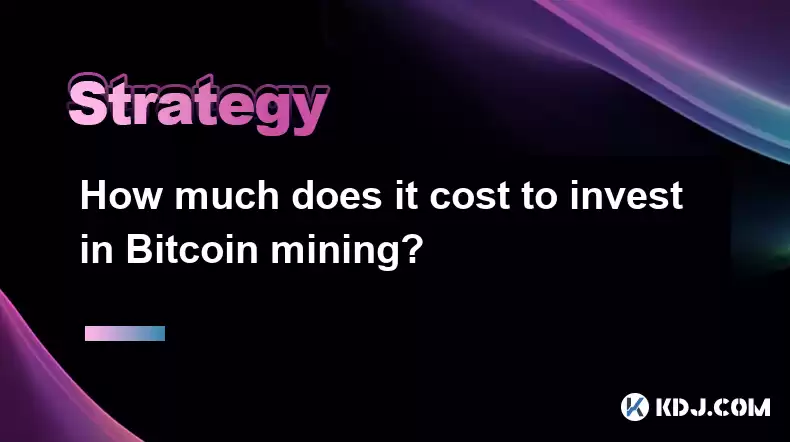-
 bitcoin
bitcoin $122025.899241 USD
-2.12% -
 ethereum
ethereum $4488.068729 USD
-4.11% -
 bnb
bnb $1315.348019 USD
8.65% -
 tether
tether $1.000457 USD
0.03% -
 xrp
xrp $2.875326 USD
-3.69% -
 solana
solana $222.043604 USD
-4.07% -
 usd-coin
usd-coin $0.999682 USD
0.00% -
 dogecoin
dogecoin $0.249887 USD
-5.62% -
 tron
tron $0.337379 USD
-2.59% -
 cardano
cardano $0.827763 USD
-5.06% -
 hyperliquid
hyperliquid $45.774531 USD
-2.43% -
 chainlink
chainlink $22.079309 USD
-5.87% -
 ethena-usde
ethena-usde $1.000156 USD
0.02% -
 sui
sui $3.482566 USD
-3.57% -
 stellar
stellar $0.386982 USD
-4.92%
How much does it cost to invest in Bitcoin mining?
Mining Bitcoin incurs expenses such as upfront hardware costs, ongoing electricity consumption, mining pool fees, maintenance costs, and cooling solutions.
Jan 07, 2025 at 06:26 pm

- Upfront Hardware Costs: Mining equipment can range from $1,000 to $10,000 or more
- Ongoing Electricity Consumption: Electricity costs can vary significantly depending on location and electricity rates
- Pool Fees: Joining a mining pool typically involves fees ranging from 1% to 5%
- Maintenance and Repairs: Equipment malfunctions and repairs can add to mining expenses
- Cooling Costs: Mining hardware generates significant heat, requiring cooling solutions that can increase costs
Investing in the hardware for Bitcoin mining is a significant upfront expense. The type of mining equipment and its processing power directly impact the potential profitability.
- ASIC Miners: These specialized machines are designed specifically for Bitcoin mining and offer the highest efficiency. They range from $1,000 to $10,000 or more.
- GPU Mining: Using graphic cards for mining is less efficient but can provide a starting point. Suitable GPUs can cost between $500 to $1,500.
- Cloud Mining: This involves renting mining capacity from a service provider, eliminating the need for hardware investment. However, it may result in lower potential returns.
Mining Bitcoin requires significant amounts of electricity, which can be a substantial ongoing cost. The electricity consumption depends on the efficiency of the mining hardware and the electricity rates in the mining location.
- High-power ASIC miners can consume up to 3,000 watts per hour, translating to monthly electricity bills of several hundred dollars.
- GPU mining is less energy-intensive but still incurs significant electricity costs.
- Choosing a location with low electricity rates can reduce mining expenses.
Most Bitcoin miners join mining pools to increase their chances of solving a block and receiving a reward. These pools charge fees for their services, typically ranging from 1% to 5% of the mining reward.
- Joining a larger pool increases the chances of finding a block but may also result in higher fees.
- Smaller pools offer lower fees but may have lower profitability due to fewer participants.
Mining hardware operates 24/7, increasing the likelihood of malfunctions and repairs. Repairs can be expensive, and the costs can accumulate over time.
- Regular maintenance, such as cleaning and temperature monitoring, can prolong the equipment's lifespan.
- Having a spare backup mining rig can minimize downtime during repairs.
Mining hardware generates substantial heat, which requires effective cooling solutions. Insufficient cooling can lead to overheating and reduced efficiency or equipment damage.
- Water-cooling systems offer superior cooling performance but can be expensive to set up.
- Air-cooling systems are more affordable but may not be as efficient in cooling high-power ASIC miners.
A: The minimum investment for Bitcoin mining depends on the equipment and location. A basic GPU mining rig can start from around $500, while ASIC miners can cost $1,000 or more.
Q: How much electricity does Bitcoin mining consume?A: Bitcoin mining consumes significant electricity, varying depending on the hardware efficiency and electricity rates. High-power ASIC miners can consume up to 3,000 watts per hour, while GPU mining is less energy-intensive.
Q: Are there any risks associated with Bitcoin mining?A: Yes, Bitcoin mining involves risks. The profitability can fluctuate significantly due to market conditions and competition. Malfunctions and repairs can also be a challenge, and there is a risk of equipment damage due to overheating.
Disclaimer:info@kdj.com
The information provided is not trading advice. kdj.com does not assume any responsibility for any investments made based on the information provided in this article. Cryptocurrencies are highly volatile and it is highly recommended that you invest with caution after thorough research!
If you believe that the content used on this website infringes your copyright, please contact us immediately (info@kdj.com) and we will delete it promptly.
- BlockDAG, DOGE, HYPE Sponsorship: Crypto Trends Shaping 2025
- 2025-10-01 00:25:13
- Deutsche Börse and Circle: A StableCoin Adoption Powerhouse in Europe
- 2025-10-01 00:25:13
- BlockDAG's Presale Buzz: Is It the Crypto to Watch in October 2025?
- 2025-10-01 00:30:13
- Bitcoin, Crypto, and IQ: When Genius Meets Digital Gold?
- 2025-10-01 00:30:13
- Stablecoins, American Innovation, and Wallet Tokens: The Next Frontier
- 2025-10-01 00:35:12
- NBU, Coins, and Crypto in Ukraine: A New Yorker's Take
- 2025-10-01 00:45:14
Related knowledge

Practical parameter settings for a Bitcoin multi-timeframe moving average system
Sep 18,2025 at 10:54pm
Optimizing Timeframe Combinations for Bitcoin Trading1. Selecting appropriate timeframes is crucial when building a multi-timeframe moving average sys...

How can I filter out false breakouts in Dogecoin high-frequency trading?
Sep 22,2025 at 01:00am
Understanding False Breakouts in Dogecoin Trading1. A false breakout occurs when Dogecoin's price appears to move beyond a defined support or resistan...

Techniques for identifying tops and bottoms in the Bitcoin on-chain NVT model
Sep 20,2025 at 07:54pm
Understanding the NVT Model in Bitcoin Analysis1. The Network Value to Transactions (NVT) ratio is often described as the 'P/E ratio' of the cryptocur...

What does the surge in open interest in Bitcoincoin futures mean?
Sep 20,2025 at 11:18pm
Understanding the Surge in Dogecoin Futures Open Interest1. A surge in open interest within Dogecoin futures indicates a growing number of active cont...

How can I use the Ethereum USDT premium to gauge market sentiment?
Sep 18,2025 at 11:55pm
Understanding the Ethereum USDT Premium1. The Ethereum USDT premium refers to the price difference between USDT (Tether) traded on Ethereum-based plat...

What should I do if Ethereum staking yields decline?
Sep 20,2025 at 06:18am
Understanding the Causes Behind Declining Ethereum Staking Yields1. The Ethereum network transitioned to a proof-of-stake consensus mechanism with the...

Practical parameter settings for a Bitcoin multi-timeframe moving average system
Sep 18,2025 at 10:54pm
Optimizing Timeframe Combinations for Bitcoin Trading1. Selecting appropriate timeframes is crucial when building a multi-timeframe moving average sys...

How can I filter out false breakouts in Dogecoin high-frequency trading?
Sep 22,2025 at 01:00am
Understanding False Breakouts in Dogecoin Trading1. A false breakout occurs when Dogecoin's price appears to move beyond a defined support or resistan...

Techniques for identifying tops and bottoms in the Bitcoin on-chain NVT model
Sep 20,2025 at 07:54pm
Understanding the NVT Model in Bitcoin Analysis1. The Network Value to Transactions (NVT) ratio is often described as the 'P/E ratio' of the cryptocur...

What does the surge in open interest in Bitcoincoin futures mean?
Sep 20,2025 at 11:18pm
Understanding the Surge in Dogecoin Futures Open Interest1. A surge in open interest within Dogecoin futures indicates a growing number of active cont...

How can I use the Ethereum USDT premium to gauge market sentiment?
Sep 18,2025 at 11:55pm
Understanding the Ethereum USDT Premium1. The Ethereum USDT premium refers to the price difference between USDT (Tether) traded on Ethereum-based plat...

What should I do if Ethereum staking yields decline?
Sep 20,2025 at 06:18am
Understanding the Causes Behind Declining Ethereum Staking Yields1. The Ethereum network transitioned to a proof-of-stake consensus mechanism with the...
See all articles










































































